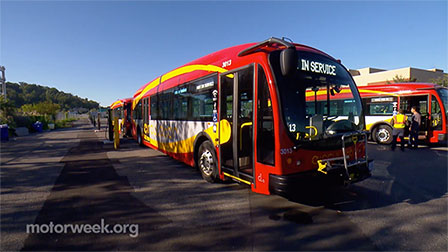Nov. 8, 2018
D.C. EV Buses (Text Version)
This is a text version of the video segment D.C. EV Buses, which aired on Nov. 8, 2018.
JOHN DAVIS: We focus a lot on the ongoing electrification of the automobile and their energy and environmental benefits. But many truck and transit bus fleets are flipping the switch to EV power too, and we think that’s a capitol idea.
As the epicenter of our nation’s government and a top tourist destination, Washington D.C., has a lot of people moving around town. And just as more and more of them are choosing efficient zero-emission personal transport, city officials saw an opportunity to improve their transit fleet as well.
In the spring of 2018, the D.C. Department of Transportation or DDOT took delivery of 14 American-made Proterra battery electric buses, making it one of the largest electric bus fleets in the country.
This purchase raises the bar again in D.C.’s “lead by example” practice when it comes to mass transit. The DDOT EV bus fleet adds to the mix of clean fuels like CNG and advanced technology electric hybrid buses that are already serving riders in the neighboring bus fleets across the D.C.-Maryland-Virginia region.
The D.C. Circulator buses transport more than 4.8 million passengers each year and travel six routes around D.C. and into Virginia, stopping at popular monuments, museums, attractions and transportation hubs along the way.
NATRESSA JACKSON: Good morning...I’m good…Good morning…alright, I like those glasses. Welcome to the Circulator. You must ring the bell when you hear your stop.
JOHN DAVIS: For driver, Natressa Jackson, switching from diesel to electric was seamless.
NATRESSA JACKSON: It’s a very smooth ride. It’s a very quiet ride.
JOHN DAVIS: In addition to being quieter, these electric buses provide riders with the benefits of free public Wi-Fi and USB charging for electronic devices, as well as informational displays for commuters and more powerful air-conditioning.
The energy and environmental impacts of the new electric bus fleet are impressive, displacing nearly 89,000 gallons of diesel per year and reducing CO2 emissions by a quarter million pounds. The Proterra buses are powered by 4 large battery packs under the floor. After charging overnight, the buses can operate for a full 10-hour shift.
JEFFERY BENNETT: It is more upfront but it’s because it’s a newer technology. Typically, newer technology costs more but over time we’ll notice or we’re hoping to notice reduced maintenance costs, which will help us on the back end. So right now, we currently have 14 electric buses. Over the coming fiscal year, we hope to purchase an additional 18 and long-term we hope to have the entire electric fleet.
JOHN DAVIS: Dozens of other cities around the country have reached the same conclusion and are investing in energy efficient zero-emission electric buses and service vehicles. And everywhere they hit the streets, these highly visible EV ambassadors are making an impact by raising awareness as well.
IRA DORFMAN: We’re having an EV revolution in the Washington D.C. area. A lot of people are purchasing electric vehicles, and this is the first opportunity for others to see that the technology really works.
